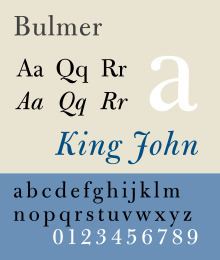Designer William Martin Date created 1792 | ||
 | ||
Link catalog.monotype.com/family/monotype/bulmer | ||
Bulmer is a transitional serif typeface originally designed by William Martin (1757–1830) in 1792 for the Shakespeare Press. The types were used for printing the Boydell Shakespeare folio edition. William Martin's typefaces show strong influence of the Baskerville typeface of John Baskerville, but with more contrast and sharper serifs. His brother John Martin had worked as Baskerville's foreman and William Martin may also have worked for him too. D. B. Updike described Martin's types as "delicate and spirited, thoroughly English." Stanley Morison described it as "a variation on the Baskerville theme".
Contents
Bulmer's distinguishing characters are an uppercase R with a curved tail. Lowercase g has a small bowl and a curved ear; a heavier stroke weight on the lower right side of the bowl contributes to a sense of that character leaning backwards. Uppercase italic characters J, K, N, T and Y are reminiscent of Baskerville's, showing the influence of his teacher. Originally drawn with ranging (old style) figures, the current Monotype revival features ranging and lining figures.
Foundry Type
Foundry type versions of Bulmer were made by the following manufacturers:
Digital Versions
A contemporary digital revival (shown at right), supervised by Robin Nicholas at Monotype Imaging is based on the 1928 revival by Morris Fuller Benton.
